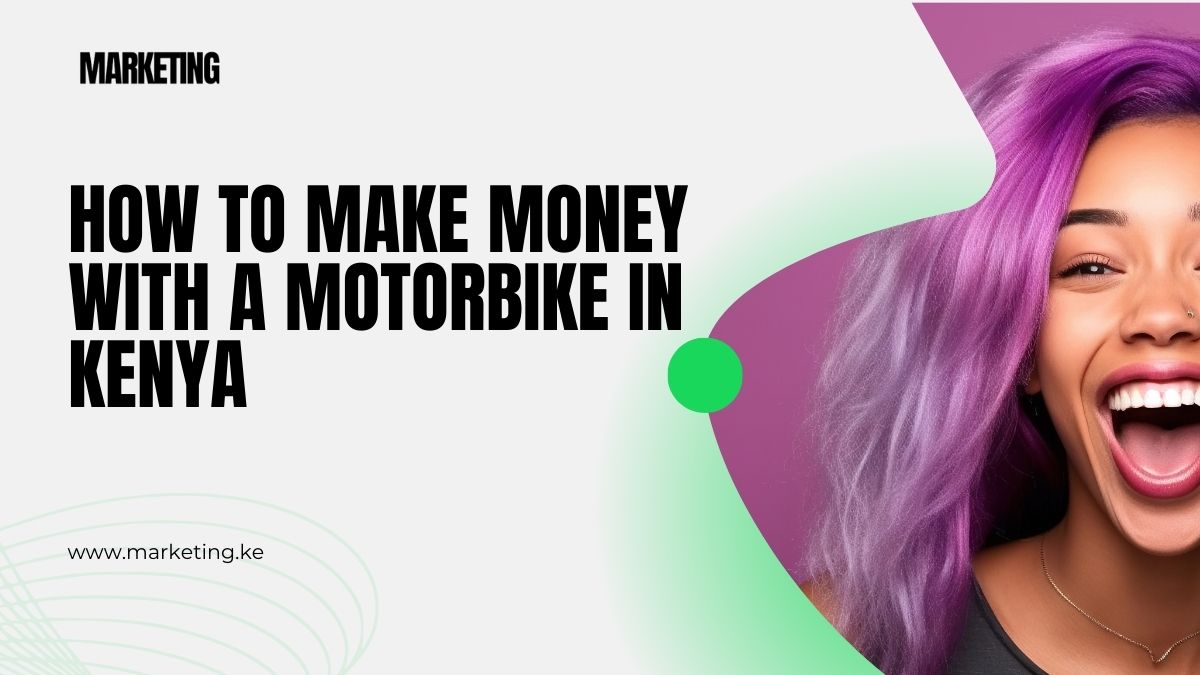How to Make Money with a Motorbike in Kenya
Picture this: It’s a bustling morning in Nairobi, and I’m weaving through traffic on my trusty motorbike.
But I’m not just commuting – I’m on my way to financial independence.
That’s right, I’ve cracked the code on how to make money with a motorbike in Kenya, and I’m here to share my secrets with you.
When I first started, I was skeptical.
Could a simple two-wheeler really be my ticket to a better life?
Turns out, it absolutely can be.
In Kenya, motorbikes aren’t just vehicles; they’re mobile money-making machines.
From delivery services to taxi rides, the opportunities are endless.
In this post, I’m going to walk you through everything you need to know to turn your motorbike into a profitable business.
We’ll cover the essentials, step-by-step instructions, tips for success, and even troubleshoot common issues.
By the end, you’ll have a roadmap (pun intended) to revving up your income and leaving financial worries in the dust.
So, are you ready to kickstart your journey to making money with a motorbike in Kenya?
Let’s dive in!
What You’ll Need
Before we hit the road to riches, let’s make sure you’re fully equipped for the journey.
Here’s what you’ll need to get started:
Essential Equipment and Resources
- A reliable motorbike: This is your most important asset. Choose wisely!
- Protective gear: Helmet, gloves, and reflective clothing are non-negotiable.
- Smartphone: For navigation, communication, and possibly running ride-hailing apps.
- Basic tool kit: For minor repairs and maintenance on the go.
- Storage solutions: Boxes or bags for carrying goods if you’re doing deliveries.
Legal Requirements
- Valid driver’s license: Specifically for motorcycles.
- Insurance: Comprehensive coverage is recommended.
- Vehicle registration: Keep it up to date.
- Business permits: Depending on your specific services.
Initial Investment Considerations
Starting a motorbike business in Kenya doesn’t have to break the bank, but you should be prepared for some upfront costs:
- Motorbike purchase or lease: Prices vary, but budget for at least 70,000 to 150,000 KES for a decent used bike.
- Gear and equipment: Factor in about 20,000 to 30,000 KES for quality protective gear and basic tools.
- Licenses and permits: Set aside around 5,000 to 10,000 KES for various fees.
- Initial fuel and maintenance: Budget about 5,000 KES to get started.
Remember, these are rough estimates.
Your actual costs may vary depending on your location and specific circumstances.
The key is to start with what you can afford and reinvest your earnings to grow your business over time.
Step-by-Step Instructions
Now that we’ve got the basics covered, let’s break down the process of turning your motorbike into a money-making machine.
Follow these steps, and you’ll be well on your way to financial success in Kenya’s bustling motorbike economy.
a. Choosing the Right Motorbike
Your motorbike is the foundation of your business, so choose wisely.
Here’s what to consider:
- Reliability: Look for brands known for durability, like Honda, Yamaha, or TVS.
- Fuel efficiency: The more kilometers per liter, the better your profits.
- Comfort: You’ll be spending long hours on this bike, so make sure it’s comfortable.
- Load capacity: If you’re planning on deliveries, ensure it can handle the weight.
- Maintenance costs: Research the availability and cost of spare parts.
Pro tip: Don’t be afraid to start with a used bike in good condition.
It’ll lower your initial investment and give you room to upgrade as your business grows.
Here’s a list of the most reliable motorbikes in Kenya:
| Motorcycle Model | Engine Capacity (cc) | Price Range (KES) | Pros | Cons |
| Bajaj Boxer | 100-150 | 100,000 – 150,000 | Affordable, fuel-efficient, durable, widely available parts | Basic features, less stylish |
| TVS Star HLX | 100-125 | 100,000 – 140,000 | Affordable, fuel-efficient, reliable, easy to maintain | Basic features, less powerful than some options |
| Honda CG 125 | 125 | 150,000 – 200,000 | Exceptional quality, longevity, performance | More expensive than other options |
| Yamaha Crux Rev | 110 | 120,000 – 160,000 | Smooth ride, fuel-efficient, stylish design | Less common parts availability compared to Bajaj or TVS |
| Hero Glamour | 125 | 110,000 – 150,000 | Affordable, stylish, practical for commuting | Relatively new in the market, less proven track record |
b. Getting Licensed and Registered
Cutting through the bureaucracy can be a pain, but it’s crucial for operating legally and avoiding hefty fines.
Here’s what you need to do:
- Obtain a motorcycle driving license: If you don’t already have one, enroll in a driving school and pass the test.
- Register your motorbike: Visit your local NTSA office with your bike’s documentation.
- Get insurance: At minimum, third-party insurance is required by law.
- Apply for necessary permits: This may include a PSV license for passenger services or a business permit for delivery operations.
Remember, compliance isn’t just about avoiding fines – it’s about building trust with your customers and partners.
c. Identifying Profitable Services
Now comes the fun part – deciding how you’ll make money with your motorbike in Kenya.
Here are some popular options in Kenya:
- Ride-hailing: Partner with apps like Bolt or SafeBoda to offer taxi services.
- Delivery services: Transport goods for businesses or individuals.
- Courier services: Specialize in document and package delivery.
- Rental services: Rent out your bike during times you’re not using it.
- Tour guide services: Offer motorcycle tours to tourists in scenic areas.
The key is to identify a niche that matches your skills and local demand.
Don’t be afraid to combine multiple services to maximize your earning potential.
d. Building Your Customer Base
No customers, no business.
Here’s how to start attracting clients:
- Leverage social media: Create business profiles on platforms like Facebook and WhatsApp.
- Network in your community: Let friends, family, and local businesses know about your services.
- Offer introductory discounts: Give new customers an incentive to try your services.
- Provide exceptional service: Word-of-mouth is powerful – make every interaction count.
- Partner with local businesses: Offer delivery services to shops or restaurants in your area.
Remember, consistency is key.
Build a reputation for reliability, and the customers will come.
e. Managing Your Finances
This is where many motorbike entrepreneurs stumble.
Don’t let poor financial management derail your success.
Follow these steps:
- Open a separate business account: Keep your personal and business finances separate.
- Track every expense and income: Use a simple app or notebook to record all transactions.
- Set aside money for taxes: Don’t get caught off guard when it’s time to pay the taxman.
- Budget for maintenance and repairs: Regular upkeep prevents costly breakdowns.
- Reinvest in your business: Use profits to improve your services or expand your operations.
Pro tip: Aim to save at least 10% of your earnings for emergencies and future growth.
By following these steps, you’ll lay a solid foundation for your motorbike business in Kenya.
Remember, success doesn’t happen overnight.
Stay patient, stay focused, and keep pushing forward.
In the next sections, we’ll dive into tips for success, common mistakes to avoid, and how to troubleshoot challenges along the way.
Tips for Success To Make Money With a Motorbike in Kenya
Alright, you’ve got the basics down.
Now let’s talk about how to take your motorbike business from surviving to thriving.
Here are my top tips for success, learned from years on the road:
Safety First
I can’t stress this enough – your safety is your top priority.
Not only does it protect you, but it also builds trust with your customers.
Here’s how to stay safe:
- Always wear proper gear: Helmet, gloves, and protective clothing are non-negotiable.
- Maintain your bike regularly: A well-maintained bike is a safe bike.
- Follow traffic rules: It’s tempting to bend the rules, but it’s not worth the risk.
- Stay alert: Avoid distractions and stay focused on the road.
- Know your limits: Don’t push yourself to work when you’re tired or unwell.
Customer Service Excellence
In a competitive market, exceptional customer service can set you apart.
Here’s how to wow your clients:
- Be punctual: Time is money for your customers. Respect it.
- Communicate clearly: Keep customers informed about delays or issues.
- Go the extra mile: A little effort can turn a one-time customer into a loyal client.
- Handle complaints gracefully: View complaints as opportunities to improve.
- Remember personal touches: A friendly greeting or remembering a regular customer’s preferences can go a long way.
Efficient Route Planning
Smart routing can significantly boost your earnings.
Here’s how to optimize your trips:
- Use navigation apps: Google Maps or Waze can help you avoid traffic and find shortcuts.
- Cluster your deliveries: Group nearby destinations to minimize empty trips.
- Learn alternative routes: Sometimes the fastest way isn’t on the map.
- Consider peak hours: Plan your schedule around traffic patterns.
- Stay flexible: Be ready to adjust your route for last-minute requests or road closures.
Maintenance and Upkeep
A well-maintained bike is crucial for your business.
Here’s how to keep your two-wheeled money-maker in top shape:
- Follow the service schedule: Don’t skip regular maintenance.
- Learn basic repairs: Knowing how to fix a flat tire or adjust your chain can save you time and money.
- Keep it clean: A clean bike not only looks professional but also helps you spot potential issues early.
- Use quality parts and fluids: Don’t cut corners on components that keep you running.
- Build a relationship with a trusted mechanic: For repairs beyond your skills, it’s invaluable to have a reliable expert.
Remember, these tips aren’t just nice-to-haves – they’re essential for long-term success.
Implement them consistently, and you’ll see the difference in your bottom line.
Common Mistakes to Avoid
Even the most successful motorbike entrepreneurs make mistakes.
The key is to learn from them quickly.
Here are some common pitfalls I’ve seen (and sometimes fallen into myself) – and how to avoid them:
Overworking Yourself
It’s tempting to work long hours to maximize earnings, but burnout is real and can derail your business.
- Set reasonable work hours: Aim for a sustainable schedule.
- Take regular breaks: Short rests throughout the day can boost productivity.
- Learn to say no: It’s okay to turn down jobs if you’re at capacity.
- Prioritize sleep: A well-rested rider is a safe and efficient rider.
Neglecting Savings
When cash is flowing, it’s easy to spend freely.
But financial discipline is crucial for long-term success.
- Set aside emergency funds: Aim for at least one month’s expenses.
- Save for taxes: Don’t get caught off guard when it’s time to pay.
- Plan for maintenance: Regular upkeep prevents costly breakdowns.
- Invest in your future: Consider long-term savings or investment plans.
Ignoring Market Trends
The motorbike business landscape in Kenya is always evolving.
Failing to adapt can leave you in the dust.
- Stay informed: Follow industry news and updates.
- Network with other riders: Share insights and experiences.
- Be open to new technologies: Embrace apps and tools that can improve your service.
- Listen to your customers: Their needs and preferences can guide your business decisions.
Poor Time Management
In this business, time truly is money.
Poor time management can cost you dearly.
- Use scheduling tools: Apps can help you organize your day efficiently.
- Estimate travel times accurately: Don’t overpromise on delivery times.
- Build in buffer time: Allow for unexpected delays.
- Prioritize tasks: Focus on high-value activities during peak hours.
By avoiding these common mistakes, you’ll set yourself up for sustainable success in your motorbike business.
Remember, every successful entrepreneur has faced challenges – it’s how you respond to them that matters.
Troubleshooting
Even with the best preparation, you’ll face challenges in your motorbike business.
Here’s how to handle some common issues:
Dealing with Mechanical Issues
Breakdowns happen.
Here’s how to minimize their impact:
- Carry a basic tool kit: For minor repairs on the go.
- Know your bike: Learn to identify unusual sounds or performance changes.
- Have a backup plan: Build relationships with other riders who can cover for you if needed.
- Maintain an emergency fund: For unexpected repair costs.
Handling Difficult Customers
Not every customer will be a joy to work with.
Here’s how to navigate tricky situations:
- Stay calm and professional: Don’t let emotions escalate the situation.
- Listen actively: Often, customers just want to be heard.
- Offer solutions: Focus on resolving the issue, not placing blame.
- Know when to walk away: Some customers aren’t worth the stress.
Navigating Slow Seasons
Business can be cyclical.
Here’s how to weather the slow times:
- Diversify your services: Offer different types of rides or deliveries.
- Build a financial cushion: Save during busy periods to cover slow ones.
- Use downtime productively: Improve your skills or maintain your bike.
- Market creatively: Run promotions or seek new customer segments.
Managing Competition
As more people discover how to make money with a motorbike in Kenya, competition will increase.
Here’s how to stay ahead:
- Focus on quality: Exceptional service will always be in demand.
- Find your niche: Specialize in a specific type of service or area.
- Build strong relationships: Loyal customers are your best asset.
- Continuously improve: Stay open to feedback and always look for ways to enhance your service.
Remember, challenges are opportunities in disguise.
Each problem you solve makes your business stronger and more resilient.
Final Thoughts
We’ve covered a lot of ground in this guide to making money with a motorbike in Kenya.
From the essential equipment you’ll need to start, through the step-by-step process of setting up your business, to tips for success and troubleshooting common issues – you now have a comprehensive roadmap to financial independence on two wheels.
Remember, success in this business isn’t just about having a motorbike and knowing how to ride it.
It’s about:
- Providing exceptional service
- Managing your finances wisely
- Staying safe and maintaining your equipment
- Adapting to market trends and customer needs
- Persevering through challenges
The road to success may have its bumps and turns, but with determination, smart planning, and the strategies we’ve discussed, you’re well-equipped to navigate them.
Whether you’re looking to supplement your income or build a thriving full-time business, the opportunities to make money with a motorbike in Kenya are vast and varied.
So, what are you waiting for?
It’s time to kick your motorbike business into high gear.
Remember, every successful entrepreneur started exactly where you are now.
The only difference is they took that first step.
Your journey to financial freedom on two wheels starts today.
Ride safe, work smart, and watch your success accelerate!
FAQ Section
Q: How much can I expect to earn with a motorbike business in Kenya?
A: Earnings can vary widely depending on factors like location, services offered, and hours worked. On average, dedicated riders can earn between 1,000 to 3,000 KES per day.
Q: Do I need special insurance for a motorbike business?
A: Yes, at minimum you need third-party insurance. However, comprehensive insurance is recommended to protect your business asset.
Q: What’s the best motorbike for business in Kenya?
A: Popular choices include brands like Honda, Yamaha, and TVS due to their reliability and fuel efficiency. The best choice depends on your specific needs and budget.
Q: How do I handle safety concerns in the motorbike business?
A: Prioritize safety by always wearing protective gear, maintaining your bike regularly, following traffic rules, and staying alert on the road.
Q: Can I start a motorbike business part-time?
A: Absolutely. Many successful motorbike entrepreneurs start part-time and gradually transition to full-time as their business grows.
Q: How do I deal with seasonal fluctuations in demand?
A: Diversify your services, build a financial cushion during busy periods, use downtime productively for maintenance or skill-building, and consider marketing strategies to attract business during slow seasons.
Q: What are the most profitable motorbike services in Kenya?
A: Ride-hailing, delivery services, and courier services are often the most profitable. However, the best option depends on your location and local market demands.
Q: Do I need to register my motorbike business?
A: Yes, you should register your business with the appropriate local authorities. This typically involves obtaining necessary licenses and permits.
Q: How can I compete with established motorbike businesses?
A: Focus on providing exceptional customer service, find a niche market, build strong relationships with clients, and continuously improve your skills and services.
Q: What’s the best way to handle customer complaints?
A: Listen actively, remain calm and professional, focus on finding solutions, and use feedback to improve your service. Remember, a well-handled complaint can turn a dissatisfied customer into a loyal one.
Q: How important is it to use ride-hailing apps?
A: While not essential, partnering with popular ride-hailing apps can provide a steady stream of customers, especially when you’re starting out. However, building your own client base is also crucial for long-term success.
Q: What should I do if my motorbike breaks down during a job?
A: Have a backup plan in place, such as a network of fellow riders who can take over the job. Always communicate promptly with your customer about any delays.
Q: How can I reduce fuel costs in my motorbike business?
A: Maintain your bike regularly for optimal fuel efficiency, plan your routes efficiently, avoid unnecessary idling, and consider investing in a fuel-efficient model.
Q: Is it better to buy or lease a motorbike for business?
A: This depends on your financial situation and long-term plans. Buying gives you an asset but requires more upfront investment. Leasing can be cheaper to start but may cost more in the long run.
Q: How do I handle tax obligations for my motorbike business?
A: Keep accurate records of all income and expenses, set aside money for taxes regularly, and consider consulting with a tax professional to ensure compliance with local regulations.
Q: What’s the best way to market my motorbike business?
A: Leverage social media, network in your community, offer excellent service for word-of-mouth referrals, and consider local advertising or partnerships with businesses in your area.
Q: How can I ensure my safety when working late hours?
A: Stick to well-lit and populated areas, trust your instincts about potentially risky situations, maintain your bike for reliability, and consider using a tracking app to share your location with trusted contacts.
Read also:








Great ideas here Kevin✅✅